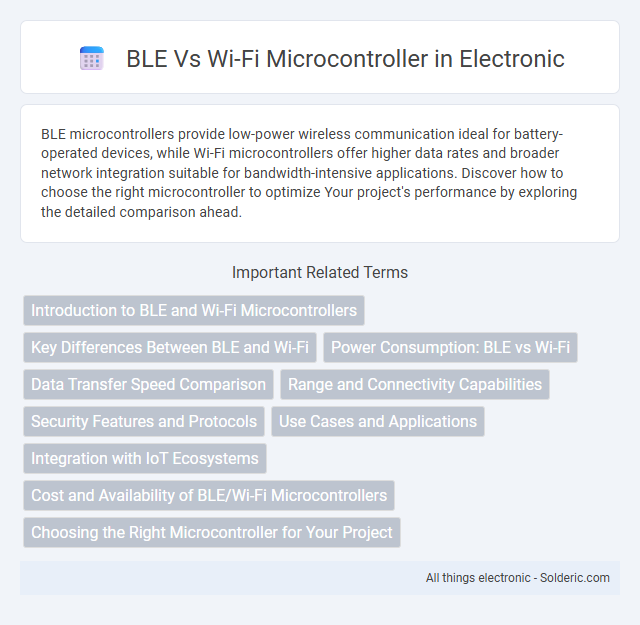BLE microcontrollers provide low-power wireless communication ideal for battery-operated devices, while Wi-Fi microcontrollers offer higher data rates and broader network integration suitable for bandwidth-intensive applications. Discover how to choose the right microcontroller to optimize Your project's performance by exploring the detailed comparison ahead.
Comparison Table
| Feature | Bluetooth Low Energy (BLE) Microcontroller | Wi-Fi Microcontroller |
|---|---|---|
| Power Consumption | Low power, ideal for battery-operated devices | Higher power usage, suitable for mains-powered devices |
| Range | Up to 100 meters (Bluetooth 5) | Up to 100 meters indoors, longer outdoors |
| Data Rate | Up to 2 Mbps (Bluetooth 5) | Up to 600 Mbps (Wi-Fi 5), higher with Wi-Fi 6 |
| Network Topology | Star, mesh (Bluetooth Mesh) | Star, infrastructure with routers and access points |
| Use Cases | Wearables, IoT sensors, health devices | Smart home hubs, streaming devices, high data apps |
| Security | AES-128 encryption, secure pairing | WPA3, AES-256 encryption, advanced security protocols |
| Cost | Generally lower cost per module | Higher cost due to complex hardware |
| Example MCUs | Nordic nRF52, TI CC2640, Espressif ESP32 BLE | Espressif ESP32 Wi-Fi, Cypress CYW43907, Microchip PIC32 |
Introduction to BLE and Wi-Fi Microcontrollers
BLE microcontrollers prioritize low power consumption and short-range wireless communication, making them ideal for IoT devices requiring efficient energy usage. Wi-Fi microcontrollers support higher data rates and longer communication ranges, suited for applications needing robust internet connectivity and greater bandwidth. Both technologies integrate microcontrollers with wireless radios, enabling smart device connectivity tailored to specific use cases.
Key Differences Between BLE and Wi-Fi
BLE microcontrollers prioritize low power consumption and are ideal for battery-operated devices requiring short-range communication, typically up to 100 meters. Wi-Fi microcontrollers support higher data rates and longer ranges, making them suitable for applications demanding robust internet connectivity and faster data transfer within a home or office network. Your choice depends on whether energy efficiency or bandwidth and range are the primary requirements for your project.
Power Consumption: BLE vs Wi-Fi
BLE microcontrollers consume significantly less power than Wi-Fi microcontrollers, making them ideal for battery-operated and low-energy IoT devices. BLE typically operates in the milliwatt range, enabling multi-year battery life, whereas Wi-Fi modules require higher power levels due to constant data transmission and longer range capabilities. This power efficiency difference directly impacts device longevity and suitability for applications needing minimal energy consumption.
Data Transfer Speed Comparison
Bluetooth Low Energy (BLE) microcontrollers typically offer data transfer speeds up to 2 Mbps, suitable for low-power, short-range applications, while Wi-Fi microcontrollers can achieve speeds ranging from 54 Mbps (802.11g) to over 1 Gbps (802.11ac/ax), supporting high-bandwidth data transmission. The significantly higher throughput of Wi-Fi microcontrollers enables real-time streaming, large file transfers, and complex data processing, which BLE cannot efficiently handle due to its low power consumption design constraints. Choosing between BLE and Wi-Fi microcontrollers depends on the application's priority for speed versus energy efficiency, with Wi-Fi favored for fast data needs and BLE for battery-sensitive, intermittent communication.
Range and Connectivity Capabilities
BLE microcontrollers provide low-power, short-range connectivity typically up to 100 meters, ideal for personal devices and sensor networks. Wi-Fi microcontrollers offer higher data rates and extended range, often exceeding 200 meters, supporting complex applications requiring internet access and broader coverage. Your choice depends on balancing energy efficiency with connectivity needs for specific IoT projects.
Security Features and Protocols
BLE microcontrollers utilize AES-128 encryption and Bluetooth Secure Connections for robust device pairing and data protection, minimizing power consumption while maintaining secure communication. Wi-Fi microcontrollers implement WPA3 security protocols, including SAE for stronger authentication and enhanced encryption, providing resilience against network attacks and unauthorized access. Both technologies support mutual authentication and secure key exchange, but Wi-Fi typically offers more advanced firewall and intrusion detection options suitable for complex network environments.
Use Cases and Applications
BLE microcontrollers excel in low-power, short-range applications such as wearable devices, health monitors, and smart home sensors, offering efficient data transfer with minimal energy consumption. Wi-Fi microcontrollers support higher data rates and longer ranges, making them ideal for smart appliances, industrial automation, and remote monitoring systems requiring robust connectivity. Your choice depends on whether energy efficiency or bandwidth and range are paramount for the specific use case.
Integration with IoT Ecosystems
BLE microcontrollers excel in low-power consumption and seamless integration with Bluetooth-enabled IoT devices such as wearables, sensors, and smart home gadgets, making them ideal for energy-efficient applications. Wi-Fi microcontrollers offer robust connectivity and higher data throughput, suitable for IoT ecosystems requiring continuous internet access and real-time data transmission, such as smart cameras and industrial automation systems. Your choice depends on balancing power efficiency and data needs to optimize performance within your IoT network.
Cost and Availability of BLE/Wi-Fi Microcontrollers
BLE microcontrollers generally offer lower cost and higher availability compared to Wi-Fi microcontrollers, making them suitable for low-power, cost-sensitive applications such as wearables and IoT sensors. Wi-Fi microcontrollers, while more expensive due to their advanced connectivity and higher power consumption, provide greater bandwidth and range, which are essential for data-intensive applications. Market trends show increasing production of BLE microcontrollers to meet demand for compact, battery-efficient devices, while Wi-Fi modules remain less prevalent but crucial for real-time, high-data-rate wireless communication.
Choosing the Right Microcontroller for Your Project
Selecting the right microcontroller depends on project requirements such as power consumption, range, and data throughput. BLE (Bluetooth Low Energy) microcontrollers excel in low-power, short-range applications like wearable devices and IoT sensors, offering efficient energy use and easy pairing. Wi-Fi microcontrollers provide higher data rates and extended range, ideal for applications needing robust connectivity and internet access, such as smart home hubs and streaming devices.
BLE vs Wi-Fi microcontroller Infographic

 solderic.com
solderic.com